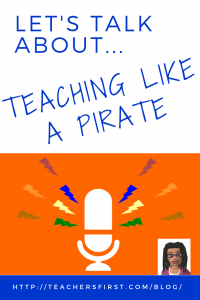 Talk Like A Pirate Day is September 19th. It is the perfect day for you to deliver an engaging lesson the Teach Like A Pirate (TLAP) way. If you are not familiar with Dave Burgess or have heard about “the pirate thing” but are unsure what all the fuss is, that’s OK. This post will help you get up to speed in time to try something new on September 19th. Let’s talk about Teaching Like A Pirate.
Talk Like A Pirate Day is September 19th. It is the perfect day for you to deliver an engaging lesson the Teach Like A Pirate (TLAP) way. If you are not familiar with Dave Burgess or have heard about “the pirate thing” but are unsure what all the fuss is, that’s OK. This post will help you get up to speed in time to try something new on September 19th. Let’s talk about Teaching Like A Pirate.
A little background on the TLAP movement is in order. Dave Burgess, the author of the book Teach Like A Pirate, explains: Pirates are daring, adventurous and willing to set forth into uncharted territories…They are entrepreneurs who take risks and are willing to travel to the ends of the earth for that which they value…That description of the pirate’s spirit sounds exactly like the character we need more of in education. The PIRATE system of teaching has six key points:
- Passion for education and feeling that passion even when the topic at hand isn’t necessarily exciting
- Immersion in the moment in order to truly engage your students
- Rapport with your students and giving them a safe place to have fun learning
- Asking and Analyzing questions to come up with creative ways to reach your students
- Transformation of your expectations to find new possibilities for your classroom
- Enthusiasm to plan and deliver high impact lessons
Dave Burgess has said that lesson planning and delivery can be seen as a Venn diagram with three circles. The first circle is your content – goals and objectives provided by your curriculum. The next circle is techniques and methods or pedagogy. The final circle is presentation – teacher creativity used to spark curiosity in the topic at hand. When planning a lesson we all think about content and methods, but we tend to forget presentation.
The first part of a presentation requires that you “hook” your audience. If you plan lessons using the 5 E’s, this is your “engagement”. Madeline Hunter calls it your anticipatory set. Skipping or minimizing this detracts from the lesson. If anything, Burgess is encouraging teachers to make this bigger and more elaborate in order to really get student attention.
You say you are not a creative type? That’s OK. We can still get you up to speed by September 19th. Take a look at Matt Miller’s 30 day Pirate Challenge. One of the links in his post is a list of ideas that you might be able to use. Card number 44 has storytelling hooks. It asks you to think about the possibility of – speaking in character, using an accent, changing intonation, and varying volume. What if on September 19th a pirate came to teach your class?
In a third grade class you might come in and explain how your band of pirates kidnapped the teacher and since your “mates” were still waiting for the ransom to be paid, the teacher begged you (the pirate) to come and teach the class for the day. In math, they could organize data comparing barnacles, starfish, and crabs using graphs.
A tenth grade English class might be engaged by a pirate teaching poetry analysis. The Shanties and Sea Songs website provides lyrics in the appropriate genre. There are plenty of ways to introduce word choice, intended text meaning, author’s purpose, imagery, literary devices and more using these songs. If dressing up is not your style, why not try a real-world application as suggested on card #24? Your students might use Animoto (reviewed here) to create and share a PSA to bring light to current pirate situations around the world.
If you‘re looking for a way to mix things up in your classroom or just want to see how students might react to the PIRATE style of teaching, don’t pass up this opportunity. The Talk Like A Pirate gang provides a primer that you can use. Speech-Language teachers can find some free shared lesson materials that feature pirates at LessonPix. You can find a geography-based piracy lesson here.
Use the comment area to tell us what you decided to try, and how it went.


Thank you for helping to enlighten us about TLAP